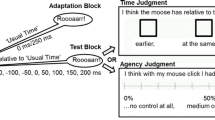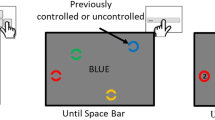Abstract
Humans experience themselves as agents, capable of controlling their actions and the outcomes they generate (i.e., the sense of agency). Inferences of agency are not infallible. Research shows that we often attribute outcomes to our agency even though they are caused by another agent. Moreover, agents report the sensory events they generate to be less intense compared to the events that are generated externally. These effects have been assessed using highly suprathreshold stimuli and subjective measurements. Consequently, it remains unclear whether experiencing oneself as an agent lead to a decision criterion change and/or a sensitivity change. Here, we investigate this issue. Participants were told that their key presses generated an upward dot motion but that on 30 % of the trials the computer would take over and display a downward motion. The upward/downward dot motion was presented at participant’s discrimination threshold. Participants were asked to indicate whether they (upward motion) or the computer (downward motion) generated the motion. This group of participants was compared with a ‘no-agency’ group who performed the same task except that subjects did not execute any actions to generate the dot motion. We observed that the agency group reported seeing more frequently the motion they expected to generate (i.e., upward motion) than the no-agency group. This suggests that agency distorts our experience of (allegedly) caused events by altering perceptual decision processes, so that, in ambiguous contexts, externally generated events are experienced as the outcomes of one’s actions.



Similar content being viewed by others
Notes
Two participants added that they started to doubt that they were generating the dot motion toward the last two blocks.
As motion direction visibility varied across trials in the preliminary experiment, mean Reaction Times are not meaningful hence are not reported.
One participant in the agency group had 100 % hit rate for the 300 ms SOA. For this particular condition and participant we used the 1/N adjustment suggested by Hautus and Lee (2006). The method consists in replacing the number of hits, Nh, with 1/Ns (where Ns is the number of signal trials) if Nh = 0, and with Nh − (1/Ns) if Nh = Ns. Other corrections have also been recommended (see Macmillan and Creelman 2005). One of these consists in replacing a 100 % hit rate with 1 − (1/2Ns). However, the Nh − (1/Ns) correction was shown to minimize the variance and confidence intervals of d' as long as Nh > 100 (see Hautus and Lee 2006). As the 1 − (1/2Ns) adjustment yielded a main group effect for c with p = 0.052 (while the alternative 1 − 1/Ns yields a p = 0.048) we are confident in concluding that the presently observed c-difference was significant at p = 0.05.
References
Blakemore SJ, Wolpert DM, Frith CD (1998) Central cancellation of self-produced tickle sensation. Nat Rev Neurosci 1(7):635–640. doi:10.1038/2870
Blakemore SJ, Wolpert DM, Frith CD (2002) Abnormalities in the awareness of action. Trends Cogn Sci 6(6):237–242. doi:10.1016/S1364-6613(02)01907-1
Buehner MJ (2012) Understanding the past, predicting the future: causation, not intentional action, is the root of temporal binding. Psychol Sci 23(12):1490–1497. doi:10.1177/0956797612444612
Burr DC, Santoro L (2001) Temporal integration of optic flow, measured by contrast and coherence thresholds. Vis Res 41(15):1891–1899
Cardoso-Leite P, Mamassian P, Schütz-Bosbach S, Waszak F (2010) A new look at sensory attenuation. Psychol Sci 21(12):1740–1745. doi:10.1177/0956797610389187
Chambon V, Haggard P (2012) Sense of control depends on fluency of action selection, not motor performance. Cognition 125(3):441–451. doi:10.1016/j.cognition.2012.07.011
Cornelissen P, Richardson A, Mason A, Fowler S, Stein J (1995) Contrast sensitivity and coherent motion detection measured at photopic luminance levels in dyslexics and controls. Vis Res 35(10):1483–1494
Daprati E, Franck N, Georgieff N, Proust J, Pacherie E, Dalery J, Jeannerod M (1997) Looking for the agent: an investigation into consciousness of action and self-consciousness in schizophrenic patients. Cognition 65(1):71–86. doi:10.1016/S0010-0277(97)00039-5
Desantis A, Roussel C, Waszak F (2011) On the influence of causal beliefs on the feeling of agency. Conscious Cognit 20(4):1211–1220. doi:10.1016/j.concog.2011.02.012
Desantis A, Weiss C, Schütz-Bosbach S, Waszak F (2012) Believing and perceiving: authorship belief modulates sensory attenuation. PLoS ONE 7(5):e37959. doi:10.1371/journal.pone.0037959
Desantis A, Roussel C, Waszak F (2014) The temporal dynamics of the perceptual consequences of action-effect prediction. Cognition 132(3):243–250. doi:10.1016/j.cognition.2014.04.010
Dewey A, Knoblich G (2014) Do implicit and explicit measures of the sense of agency measure the same thing?. PLoS ONE 9(10):e110118. doi:10.1371/journal.pone.0110118
Farrer C, Valentin G, Hupé JM (2013) The time windows of the sense of agency. Conscious Cogn 22(4):1431–1441. doi:10.1016/j.concog.2013.09.010
Franck N, Farrer C, Georgieff N, Marie-Cardine M, Daléry J, D’Amato T, Jeannerod M (2001) Defective recognition of one’s own actions in patients with schizophrenia. Am J Psychiatry 158(3):454–459. doi:10.1176/appi.ajp.158.3.454
Gallagher S (2000) Philosophical conceptions of the self: implications for cognitive science. Trends Cogn Sci 4(1):14–21. doi:10.1016/S1364-6613(99)01417-5
Green DM, Swets JA (1966) Signal detection theory and psychophysics. New York, Wiley
Green DM, Luce RD (1971) Detection of auditory signals presented at random times: III. Percept Psychophys 9(3):257–268. doi:10.3758/BF03212645
Hautus MJ, Lee A (2006) Estimating sensitivity and bias in a yes/no task. Br J Math Stat Psychol 59(Pt 2):257–273. doi:10.1348/000711005X65753
Hughes G, Desantis A, Waszak F (2013) Mechanisms of intentional binding and sensory attenuation: the role of temporal prediction, temporal control, identity prediction, and motor prediction. Psychol Bull 139(1):133–151. doi:10.1037/a0028566
Hume D (1920) A treatise of human nature. Dent, London
Kesten H (1958) Accelerated stochastic approximation. Ann Math Stat 29(1):41–59
Longo M, Haggard P (2009) Sense of agency primes manual motor responses. Percept 38(1):69–78. doi:10.1068/p6045
Luce RD (1991) Response times: their role in inferring elementary mental organization. Oxford University Press, Oxford
Macmillan NA, Creelman CD (2005) Detection theory: a user’s guide. Lawrence Erlbaum Associates, London
Nielsen (1963) Volirion: a new experimental approach. Scand J Psychol 4:225–230
Pelli DG (1997) The video toolbox software for visual psychophysics: transforming numbers into movies. Spat V 10(4):437–442. doi:10.1163/156856897X00366
Posner MI (1980) Orienting of attention. Q J Exp Psychol 32(1):3–25
Repp BH, Knoblich G (2007) Toward a psychophysics of agency: detecting gain and loss of control over auditory action effects. J Exp Psychol Hum Percept Perform 33(2):469–482. doi:10.1037/0096-1523.33.2.469
Roussel C, Hughes G, Waszak F (2013) A preactivation account of sensory attenuation. Neuropsychologia 51(5):922–929. doi:10.1016/j.neuropsychologia.2013.02.005
Roussel C, Hughes G, Waszak F (2014) Action prediction modulates both neurophysiological and psychophysical indices of sensory attenuation. Front Hum Neurosci 8:115. doi:10.3389/fnhum.2014.00115
Sato A (2008) Action observation modulates auditory perception of the consequence of others’ actions. Conscious Cognit 17(4):1219–1227. doi:10.1016/j.concog.2008.01.003
SanMiguel I, Widmann A, Bendixen A, Trujillo-Barreto N, Schröger E (2013) Hearing silences: human auditory processing relies on preactivation of sound-specific brain activity patterns. J Neurosci 33(20):8633–8639. doi:10.1523/JNEUROSCI.5821-12.2013
Sato A, Yasuda A (2005) Illusion of sense of self-agency: discrepancy between the predicted and actual sensory consequences of actions modulates the sense of self-agency, but not the sense of self-ownership. Cognition 94(3):241–255. doi:10.1016/j.cognition.2004.04.003
van den Bos E, Jeannerod M (2002) Sense of body and sense of action both contribute to self-recognition. Cognition 85(2):177–187. doi:10.1016/S0010-0277(02)00100-2
Waszak F, Cardoso-Leite P, Hughes G (2012) Action effect anticipation: neurophysiological basis and functional consequences. Neurosci Biobehav Rev 36(2):943–959. doi:10.1016/j.neubiorev.2011.11.004
Wegner DM, Sparrow B (2004) Authorship processing. In: Gazzaniga M (ed) The cognitive neurosciences, 3rd edn. MIT Press, Cambridge, p 1201–1209
Wegner DM, Wheatley T (1999) Apparent mental causation: sources of the experience of will. Am Psychol 54(7):480–492. doi:10.1037/0003-066X.54.7.480
Weiss C, Herwig A, Schütz-Bosbach S (2011) The self in action effects: Selective attenuation of selfgenerated sounds. Cognit 121(2):207–218. doi:10.1016/j.cognition.2011.06.011
Wolpert DM (1997) Computational approaches to motor control. Trends Cogn Sci 1(6):209–216. doi:10.1016/S1364-6613(97)01070-X
Acknowledgments
We thank Ilona Kovacs for constructive discussions while this project was in its conception phase. We are grateful to Vivianne Huet for data collection. F. Waszak was supported by the European Research Council (ERC) under the European Union’s Seventh Framework Programme (FP7/2007-2013)/ERC Grant Agreement 263067. A. Gorea was supported by a grant de l’Agence National de la recherche ANR-12-BSH2-0005-01.
Author information
Authors and Affiliations
Corresponding author
Rights and permissions
About this article
Cite this article
Desantis, A., Waszak, F. & Gorea, A. Agency alters perceptual decisions about action-outcomes. Exp Brain Res 234, 2819–2827 (2016). https://doi.org/10.1007/s00221-016-4684-7
Received:
Accepted:
Published:
Issue Date:
DOI: https://doi.org/10.1007/s00221-016-4684-7




